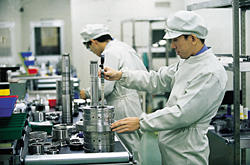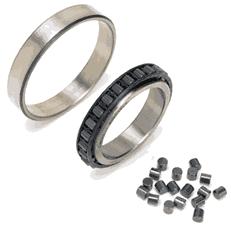
Summary
High-precision bearings
Matsuura Machinery Corporation makes high-speed milling machines and machining centres. Even in extremely high-speed machining centres, the company uses cylindrical roller bearings for the rear side bearing of the spindles, to keep high spindle stiffness and high productivity.
However, a few years ago, the company encountered the limitations of conventional cylindrical roller bearings. So they requested that SKF develop a hybrid cylindrical roller bearing with higher speed capability and a reasonable price level. SKF has been one of Matsuura’s basic suppliers for 30 years, keeping up with the high-speed spindles that Matsuura needs.
Based on Matsuura’s requirements, SKF started to develop the hybrid single row cylindrical roller bearings in 1996. After several internal and field tests, SKF succeeded in developing a new high-precision cylindrical roller bearing with ceramic rollers and the newly designed PEEK cage. Matsuura was satisfied with the result and has decided to use a new bearing for all high-speed machining centres.
Creating machine tools that are both fast and accurate is a challenge. Japan’s Matsuura Machinery Corporation has got the right mix.Matsuura Machinery Corporation shows that you don’t need to be gigantic to succeed when you have a competitive edge in your field. In Matsuura’s case, the company’s competitive edge is speed, as in high-speed machining.
Speed, says Masanori Matsuura, the company president, is the key and will continue to be in the future. And the LX-1, Matsuura’s latest high-speed milling machine, is the company’s best example of this speed. Featuring 60,000 revolutions per minute, it received considerable interest at the 19th Japan International Machine Tool Fair held in October 1998 in Osaka, Japan.
Matsuura, which employs a staff of 600, is headquartered in the Fukui Prefecture on Japan’s west coast. From there the company is aiming at the European market, with its speciality – custom-made machinery. But Matsuura machine tools sell well in the U.S. market as well.
A driving philosophy of the company is global partnership using first-class materials. “To produce a first-class product, first-class parts are required from our partners,” Masanori Matsuura says. “If you have first-class parts, half of the work is already achieved.”
Speed, efficiency and accuracy
There is no way to miss the LX-1. It is bright red –a long-time feature of Matsuura’s machines. Koichi Amaya, general manager of the engineering department, explains the features of the LX-1: “We use a linear motor from a German company to increase the feed to support the high-speed spindle, which optimises the cutting efficiency. But speed and high productivity are not the only things that makes the LX-1 attractive to the market.
It also features an extremely high accuracy. Hardly any cooling lubricant is required, since the metal chips take all the heat. And the fast rotation keeps the pressure on the cutting tool to a minimum.”
In the market, there are several machines with linear motors to make car engine blocks. That is not the case in the precise iron die and mould market, the intended market for the LX-1 and a field that Amaya predicts will expand.
From belt-driven lathes
In 1935, Toshio Matsuura started his business in Fukui Prefecture, manufacturing belt-driven lathes. Some 22 years later, the company manufactured its first milling machine. The present president, Masanori Matsuura, took over in 1985 and drew up the current strategy. “Important turning points in our history were when we started to accept custom orders and when we started to export to the U.S. in 1975. When the (Japanese) Ministry of Finance strengthened the yen in the 1985 Plaza Agreement, we had to choose where to go. Quality was our mark, as well as ‘something new, something different’ and our speciality was high-speed machining – 25,000 revolutions per minute and up.”
This quality is evidenced by the attention to such detail as cleanliness. The Matsuura factory is strikingly clean – not at all the popular image of industrial manufacturing. But cleaner still is the “Clean Room,” which has a cleanliness level similar to that of an operating room. There is special illumination of 900 Lux, and the temperature is 20 degrees Celsius. The three employees working in the room are outfitted in sterile clothing, creating an atmosphere of science fiction.
“Matsuura relies on partners to supply all of its materials,” Amaya says. “The basic policy in choosing a partner is simply to look for the best equipment from suppliers, to maintain the quality of our products.” Developing technology with these partners that promotes greater speed is crucial for Matsuura. Katsutoshi Matsuura, managing director, adds to that the factor of cutting time. “In exchanging tools, air cutting time is an important factor,” he says, “but from our point of view, we concentrate on reducing the actual cutting time rather than air cutting time.”
So 15 years ago Matsuura asked Yaskawa Electric if they could make the necessary NC (numerical control) software. Together with Yaskawa, Matsuura’s Z-Lug G-Code software has been custom-made for high-speed milling. Response is quick, it is accurate and reliable, and it enables sharp turns at very high-speed manoeuvring.
Towards the next century
At the end of this century Matsuura is taking steps into the next with its Factory Explorer. It consists of an Ethernet network that enables Java-based communication between several machines and PC computers. It is a convenient way to manage remote operations, for instance NC programs and changing tools. Another key aspect of Matsuura is the company’s global presence. There is a production facility in Coalville in Britain, and service and sales centres in Germany and Canada. “The reason for setting up the production facility in the U.K. was that we wanted to be where the market is, and where the skill is,” Matsuura says.
Matsuura exports some 70 percent of its products. In 1997 figures show that 40 percent went to the U.S. and 30 percent to Europe.
In 1998, sales to Europe increased; custom orders are more suitable for the European market. Basically, Matsuura’s policy is to sell through a country’s existing distributor system, facilitating communication and avoiding cultural misunderstandings. But in the U.K., Canada and Germany, they do direct sales and service.
Matsuura leads his company with an open spirit, which is reflected in the friendly and relaxed atmosphere at the factory. In his view, the ties with people are what make the difference. “Those are the ties that last,” he says and concludes, “This is the partnership era, where we must collaborate to meet the challenges of the 21st century.”
Maria Olsson
a writer with Text Inc.Tokyo
photos Jun Takagi






